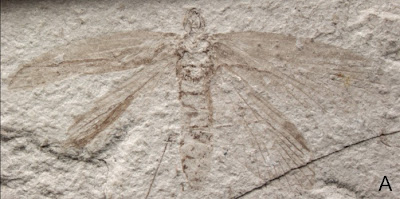The Lepidoptera (Butterflies and Moths) first appear in the fossil record in the Early Jurassic of southern England, though they may be a little older; their closest relatives, the Caddisflies (Trichoptera) being known from the Late Triassic. Fossil Lepidopterans are not numerous in Mesozoic deposits, suggesting that the group did not become a major component of Insect faunas until the Cenozoic.
In a paper published in the journal PLoS One on 22 November 2013, a team of scientists led by Weiting Zhang of the College of Life Sciences at Capital Normal University in Beijing and the Geoscience Museum of the Shijiazhuang University of Economics describe fourteen new species of Moths from the Middle Jurassic Jiulongshan Formation from Daohugou Village in Inner Mongolia.
The first new species described is named Seresilepidopteron dualis, where 'Seresilepidopteron' means 'Lepidopteran from northwest China' and 'dualis' means 'twice'. This is a 4.3 mm Moth described from two specimens, thought to be members of the same species but different sexes.
Seresilepidopteron dualis, female specimen. Zhang et al. (2013).
The second new species is named Akainalepidopteron elachipteron, where 'Akainalepidopteron' means 'spiny Lepidopteran' and 'elachipteron' means 'short wing'. The species is described from two female specimens and a partial specimen of uncertain sex. The Moths were about 7.2 mm in length, with forewings shorter than the body.
Akainalepidopteron elachipteron, female specimen. Zhang et al. (2013).
The third new species described is named Dynamilepidopteron aspinosus, where 'Dynamilepidopteron' means 'Powerful Lepidopteran' and 'aspinosus' means 'lacking spines'. The species is described from a single male specimen, 7 mm in length.
Dynamilepidopteron aspinosus, male specimen. Zhang et al. (2013).
The fourth new species described is named Quadruplecivena celsa, where 'Quadruplecivena' means 'quadruple-veined' and 'celsa' means 'noble'. The species is described from a single male specimen, 9.5 mm in length.
Quadruplecivena celsa, male specimen. Zhang et al. (2013).
The fifth new species described is named Petilicorpus cristatus, where 'Petilicorpus' means 'thin bodied' and 'cristatus' means 'crested'. The species is described from a single female specimen, 6.6 mm in length.
Petilicorpus cristatus, female specimen. Zhang et al. (2013).
The sixth new species described is named Longcapitalis excelsus, where 'Longcapitalis' means 'long headed' and 'excelsus' means 'large'. The species is described from a single female specimen, preserved as part and counterpart, 7.9 mm in length.
Longcapitalis excelsus, female specimen. Zhang et al. (2013).
The seventh new species described is named Grammikolepidopteron extensus, where 'Grammikolepidopteron' means 'linear Lepidopterean' and 'extensus' means 'extended'. The species is described from a single female specimen preserved as part and counterpart, 3.8 mm in length, but missing the tip of the abdomen.
Grammikolepidopteron extensus, female specimen. Zhang et al. (2013).
The eighth new species described is placed in the genus Mesokristensenia, and given the specific name trichophora, meaning hair-carrier, a reference to a cluster of hairs on the base of the antennae. Mesokristensenia trichophora is described from a single female specimen, 5.1 mm in length.
Mesokristensenia trichophora, female specimen, with detail of the head inset, arrows pointing to the clusters of hairs at the base of the antennae. Zhang et al. (2013).
The ninth new species described is named Kladolepidopteron oviformis, where 'Kladolepidopteron' means 'branched Lepidopteran' (a reference to the wing-venation) and 'oviformis' means 'egg-shaped' in reference to a pair of oval structures on the first segment of the thorax. The species is described from a single female specimen, 6.3 mm in length.
Kladolepidopteron oviformis, female specimen. Zhang et al. (2013).
The tenth new species described is also placed in the genus Kladolepidoteron, and is given the specific name subaequalis, meaning 'less than equal', a reference to the wing venation. Kladolepidopteron subaequalis is described from a 5 mm specimen of indeterminate sex and an isolated forewing.
Kladolepidopteron subaequalis, specimen of indeterminate sex. Zhang et al. (2013).
The eleventh new species described is again placed in the genus Kladolepidoteron, and is given the specific name parva, meaning small. Kladolepidopteron parva is described from a single male specimen, 4.1 mm in length, preserved as part and counterpart.
Kladolepidopteron parva, male specimen, part and counterpart. Zhang et al. (2013).
The twelfth new species described is given the name Ascololepidopterix multinerve, where 'Ascololepidopterix' means 'Lepidopteran without spurs' and 'multinerve' means 'many-sinewed', a reference to the wing venation. The species is described from a single 8.1 mm specimen of indeterminate sex.
Ascololepidopterix multinerve, specimen of indeterminate sex. Zhang et al. (2013).
The thirteenth new species described is given the name Pegolepidopteron latiala, where 'Pegolepidopteron' means 'large Lepidopteran' and 'latiala' means 'broad winged'. The species is described from a single 7.7 mm female specimen.
Pegolepidopteron latiala, female specimen. Zhang et al. (2013).
The final new species is named Trionolepidopteron admarginis, where 'Trionolepidopteron' means 'Three Lepidopteran', a reference to the wing venation, and 'admarginis' means 'towards the border', another reference to the wing venation. The species is described from a single 3.8 mm partial specimen of indeterminate sex.
Trionolepidopteron admarginis, specimen of indeterminate sex. Zhang et al. (2013).
See also Leaf mimicry in a Jurassic Scorpionfly, A new species of Split-foot Lacewing from the Middle Jurassic of Inner Mongolia, A Caddisfly from the Middle Jurassic of Inner Mongolia, Choristopsychid Insects from the Middle Jurassic of Inner Mongolia and Four new species of Mantidfly from the Mesozoic of China.
Follow Sciency Thoughts on Facebook.















